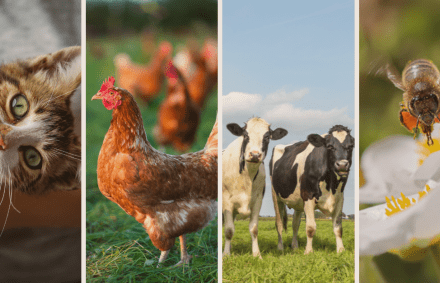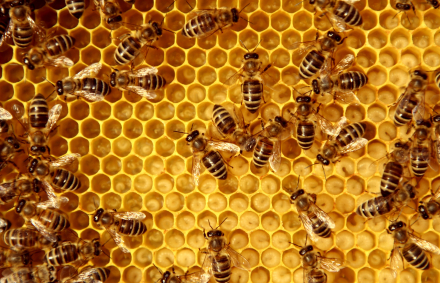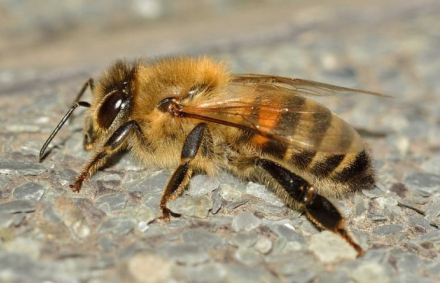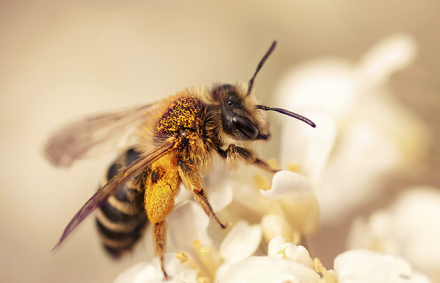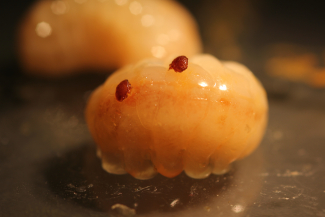
Varroa, or Varroa destructor, is a parasitic mite that infests beehives. It originates from Java, but is now established almost everywhere in the world, except for a few islands. It is the biggest problem facing beekeeping worldwide.
This parasite feeds on adult bees and their brood. For this purpose, it has an elongated, saw-knife-shaped mandible, with which it breaks the bee's protective exoskeleton and sucks out its fat with a kind of tube (proboscis). By consuming fat reserves, it impedes the metamorphosis of the brood and the proper functioning of the adult bees' bodies, making them less active, shortening their life span, and making them more prone to disease. Their activity transmits disease-causing viruses and bacteria to bees and their brood.

The Varroa cycle
It has two phases:
- When young, a varroa attaches itself to the adult bees in the hive, feeding on their abdominal fat reserves. It remains on them for 3 to 10 days, until its development is complete. This phase is called the varroa phoretic phase, and it is the only phase in which the mites are exposed to the action of the acaricides that are used to control them. These varroa are difficult to see, as most of them attach themselves to the ventral part of the bees, between the rings.

The varroa's preferred locations .By Samuel D. Ramsey - https://doi.org/10.1073/pnas.1818371116, CC BY 4.0, https://commons.wikimedia.org/w/index.php?curid=80224455 - Once mature, the varroa enters a cell on the verge of operculation—which it recognises because the larva emits an operculation pheromone—and it is there, under the operculum, that it carries out its reproductive cycle: 60-70 hours after the cell closes, it lays its first male egg, and every 30 hours thereafter it lays successive female eggs. These eggs develop into larvae, nymphs, and, finally, adult individuals.
It takes 6-7 days for the male egg to develop into a fertile adult, and 5-6 days for the female egg. Inside the parasitized cell, the male will fertilize the successive females that reach maturity. When the cell opens, 12 ±1 days after closure if it was a worker cell, or 15 ±1 days if it was a drone cell, the fertilised female varroa emerge. The worker bees will clean the brood cell, eliminating the male varroa and the female larvae that did not reach full term.
Population growth
Varroa will enter a hive on pecorating bees that mistakenly return to neighbouring hives (about 20%), or by plundering, or on drones. Normally, they will immediately move to the nearest comb with operculating cells and begin their breeding cycle.
From there the varroa population will gradually spread to the rest of the brood, eventually reaching the drone cells, which are usually on the periphery of the brood nest, and for which it has a special preference.
About 1/4 of the varroa in a hive will be in the phoretic phase, attached to adult bees, and the remaining 3/4 on the brood, under the opercula, reproducing.
Some varroa are sterile, and do not produce offspring. Mikitjut, 1976, measured that 78% of reproducing varroa have only one laying cycle, 18% have two, and only 4% have three.
There are some forces in the hive that oppose varroa population growth:
- The delousing behaviour of some workers: they remove the varroa from their bodies and bite them with their jaws, “grooming.”
- Varroa-sensitive hygiene (VSH) behaviour: some workers can detect the warning substances produced by their pupae when larvae start to hatch from varroa eggs and feed on them. This occurs on days 6 to 8 of operculation, when the pupal head is formed and the eyes begin to colour. This behaviour involves un-operculating the parasitized cells, cleaning them and, in some cases, re-operculating them once the parent varroa has emerged and its brood has been eliminated.

The varroa population will grow more or less rapidly in a hive depending, among other factors, on the % of fertile varroa, the number of reproductive cycles they make, and whether they parasitise only worker cells or if they are able to parasitise drone cells.
Depending on the relative importance of the varroa's forces of growth and the bee's forces of varroa control, the result will be either rapid population growth with disappearance of the hive within a short period of time, up to around 9 months, or tolerance by the hive of a certain varroa load, which may survive for several years, but with a significant decrease in productivity.
On average, in a worker cell there are 1.5-1.7 varroa for every one that enters, and in drone cells almost twice as many: 2.7. This means that every month the number of varroa is multiplied by two in brood hives, or by three if there is a large drone brood.
For further information: Fernández & Coineau, “Varroa. El verdugo de las abejas” [Varroa: The Bee Executioner], 2002.
